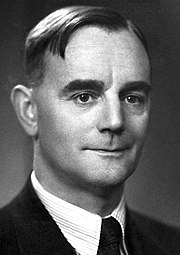Cecil Powell
| C. F. Powell | |
|---|---|
 |
|
| Born | Cecil Frank Powell 5 December 1903 Tonbridge, Kent, England, United Kingdom |
| Died | 9 August 1969 (aged 65) Valsassina, Italy |
| Citizenship | British |
| Nationality | English |
| Fields | Physics |
| Institutions |
University of Cambridge University of Bristol |
| Alma mater | University of Cambridge |
| Doctoral advisor |
C. T. R. Wilson Ernest Rutherford |
| Known for |
Photographic method Discovery of the pion |
| Notable awards | Nobel Prize in Physics (1950) Hughes Medal (1949) Fellow of the Royal Society (1949) Royal Medal (1961) Lomonosov Gold Medal (1967) |
Cecil Frank Powell, FRS (5 December 1903 – 9 August 1969) was an English physicist, and Nobel Prize in Physics laureate for his development of the photographic method of studying nuclear processes and for the resulting discovery of the pion (pi-meson), a subatomic particle.
Powell was born in Tonbridge, Kent, England, the son of a local gunsmith, and educated at a local primary school before gaining a scholarship to the Judd School, Tonbridge, which now has one of its four houses named after Powell (the house colour is green), and awards the Powell Physics and Mathematics Prize to an upper sixth form student every year in his honour. Following this he attended Sidney Sussex College, Cambridge, graduating in 1925 in the natural sciences. After completing his bachelor's degree he worked at the Cavendish Laboratory, Cambridge, under C.T.R. Wilson and Lord Rutherford, conducting research into condensation phenomena, and gaining his Ph.D. in Physics in 1927.
In 1928 he took up a post as Research Assistant to A.M. Tyndall in the H.H. Wills Physical Laboratory at the University of Bristol, later being appointed lecturer, and in 1948 appointed Melville Wills Professor of Physics. In 1932 Powell married Isobel Artner (1907-1995), and the couple had two daughters. In 1936 he took part in an expedition to the West Indies as part of a study of volcanic activity, and where he appears on a stamp issued in Grenada.
During his time at Bristol University, Powell applied himself to the development of techniques for measuring the mobility of positive ions, to establishing the nature of the ions in common gases, and to the construction and use of a Cockcroft generator to study the scattering of atomic nuclei. He also began to develop methods employing specialised photographic emulsions to facilitate the recording of the tracks of elementary particles, and in 1938 began applying this technique to the study of cosmic radiation, exposing photographic plates at high-altitude, at the tops of mountains and using specially designed balloons, collaborating in the study with Giuseppe Occhialini, H. Muirhead and young Brazilian physicist César Lattes. This work led in 1946 to the discovery of the pion (pi-meson), which proved to be the hypothetical particle proposed in 1935 by Yukawa Hideki in his theory of nuclear physics.
...
Wikipedia
